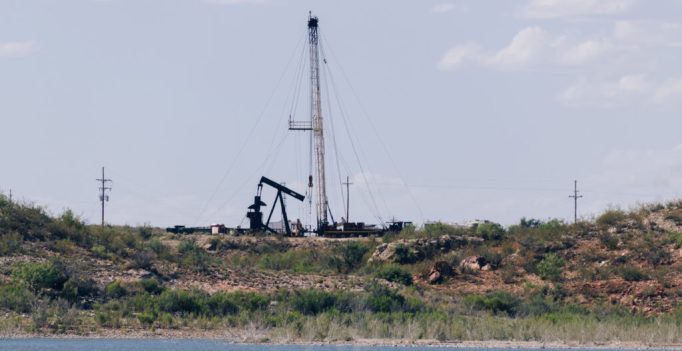These days the Pecos River barely fills its dry, sandy bed where it crosses West Texas, but the river could be poised to flow again — with treated oilfield wastewater.
Companies are racing to figure out what to do with the tremendous volume of noxious water that comes up from underground during oil and gas drilling in the Permian Basin, but a growing cohort of companies say they’ve developed a means to purify that fluid and release it in the Pecos and other watersheds.
“This is new ground for all of us and we know it’s got to be done the right way,” said Robert Crain, executive vice president of Texas Pacific Water Resources, a company seeking to discharge treated water. “We’re not the only folks that are chasing this.”
For decades, oil drillers have injected their wastewater, known as “produced water,” back underground for disposal. But an intensifying spate of earthquakes tied to produced water injection wells in recent years has prompted the Railroad Commission of Texas, which regulates drilling and injection, to tighten restrictions on injection disposal, spurring a search for alternatives.
After two years of studies, the company is applying for a state permit to discharge up 840,000 gallons per day of treated oilfield wastewater into a tributary of Salt Creek, which feeds into the Pecos River. That volume won’t turn the Pecos into a roaring river but it could open doors for larger projects that could transform the river.
The Texas Commission on Environmental Quality issued a permit for a company to discharge produced water in Atascosa County, southeast of San Antonio in the Eagle Ford Shale basin, earlier this year and is reviewing another application near Eagle Pass. A second company has also applied to discharge into the Pecos River watershed.
But scientists and environmental advocates have raised questions about the impacts of introducing this new waste stream into rivers. Federal regulations for these discharges are limited, delegating individual states to oversee their environmental and health impacts. Now responsibility lies with TCEQ to set requirements for these new discharges and the myriad pollutants found in produced water.
Everything from naturally occurring radioactive material, to dozens of toxic drilling lubricants, to “forever chemicals” known as PFAS have been detected in produced water. Existing water quality standards do not cover many of these constituents, leaving regulators to evaluate the risk of these discharges with limited toxicity data.
Texas joins states like Pennsylvania and Wyoming that are among the few that have permitted produced water discharges. Pollution problems related to produced water discharges have been documented in both states. In neighboring New Mexico, regulators have decided to wait for more scientific study before issuing permits for discharges.
“Let’s make sure that, as they develop their plans, they keep the best interest of the river in mind and not just some nebulous idea that it’s a place to dump water anytime you want to.”
When it comes to produced water reuse, some companies are putting in serious effort to do it safely, said Ira Yates, founder of Friends of the Pecos and heir to a West Texas oil fortune. But he worries that if the gates are opened on discharges, other startups won’t be as thoughtful.
“All people are really trying to do is get rid of their water so they can pump more oil,” said Yates. “Let’s make sure that, as they develop their plans, they keep the best interest of the river in mind and not just some nebulous idea that it’s a place to dump water anytime you want to.”
A TCEQ spokesperson, Richard Richter, said the agency’s water quality standards “comply with state and federal water quality rules” and are “protective of surface water quality, human health, and the environment.” He said the agency will set limits on specific pollutants in produced water and that these limits could include both pollutants that are currently regulated and those that are not.
Texas Ramps Up Discharge Permit Program
Produced water is typically injected underground through thousands of disposal wells around the state. But restrictions have been tightened on disposal wells since they have been linked to earthquakes in West Texas. Chevron CEO Mike Wirth said last year that disposal capacity in the Permian Basin “is becoming an issue.” The company had to reduce deep injection by 75 percent in one of the seismic areas, according to the Permian Basin Petroleum Association magazine.
Oil and gas producers recycle a small portion of produced water. Treating the water, which can be ten times saltier than seawater and is often laced with leftover fracking chemicals, has been uneconomical so far, especially compared with the low cost of injection disposal.
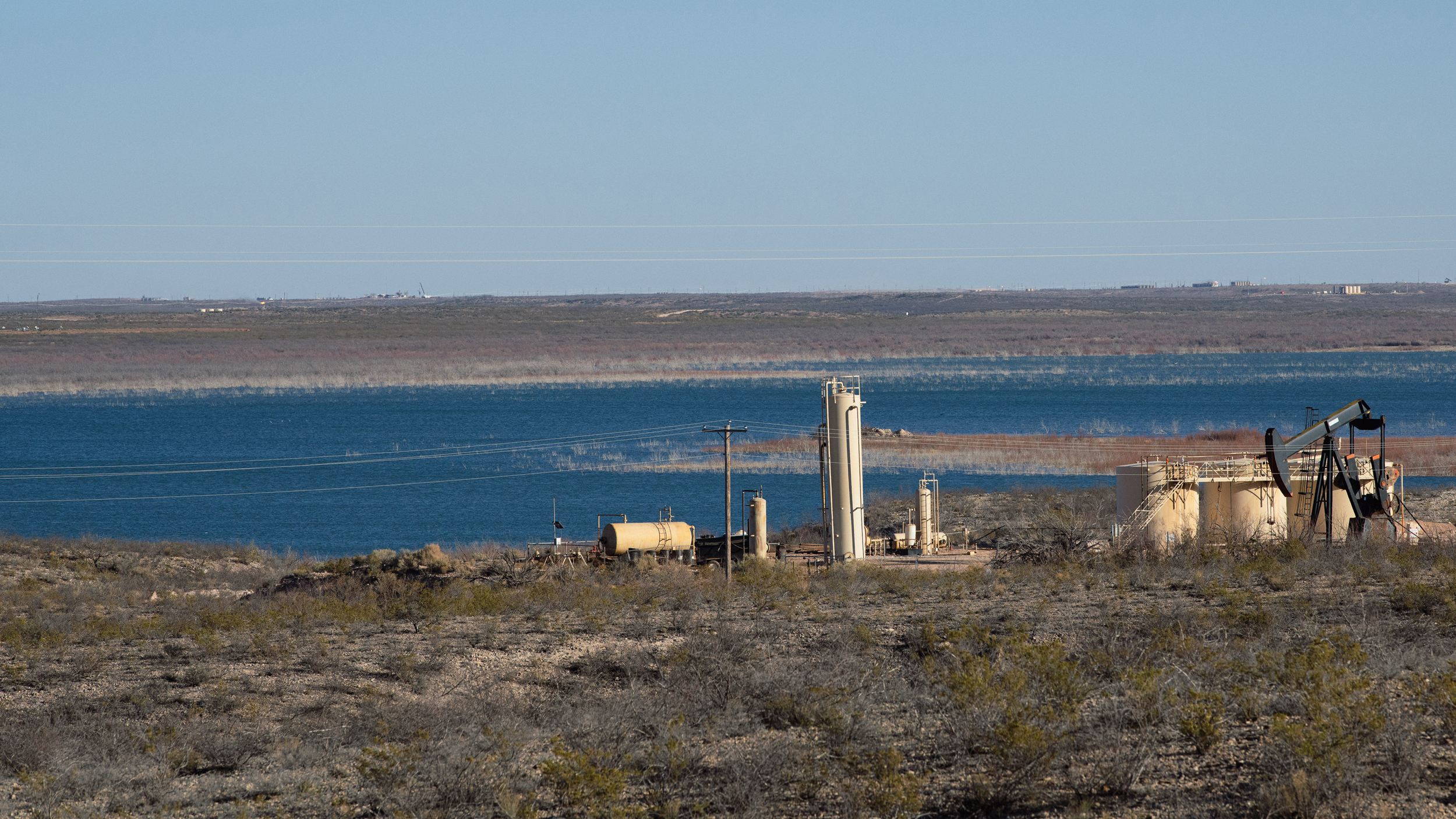
West of the 98th Meridian, a north-south line that roughly divides the arid West from the water-rich East, the Environmental Protection Agency delegates authority to states to permit discharges of produced water into bodies of water. EPA numerical standards for produced water discharges only cover oil and grease, leaving states to determine what other constituents to regulate.
These discharges must be beneficial to wildlife or agriculture, according to EPA regulations. Among Western states, Wyoming has authorized such discharges for over two decades. Colorado’s Water Quality Control Division has 14 permits issued for discharges of produced water to surface water.
California does not permit discharges into rivers but has permitted select discharges into waterways that only flow part of the year, according to the State Water Board’s Division of Water Quality. New Mexico is yet to approve discharges of produced water.
In the East, Pennsylvania authorized discharges of treated produced water from central wastewater treatment plants into rivers. However, Pennsylvania State University researchers later found elevated levels of salt and radioactive chemicals likely linked to the Marcellus Shale formation in sediments downstream of the discharges.
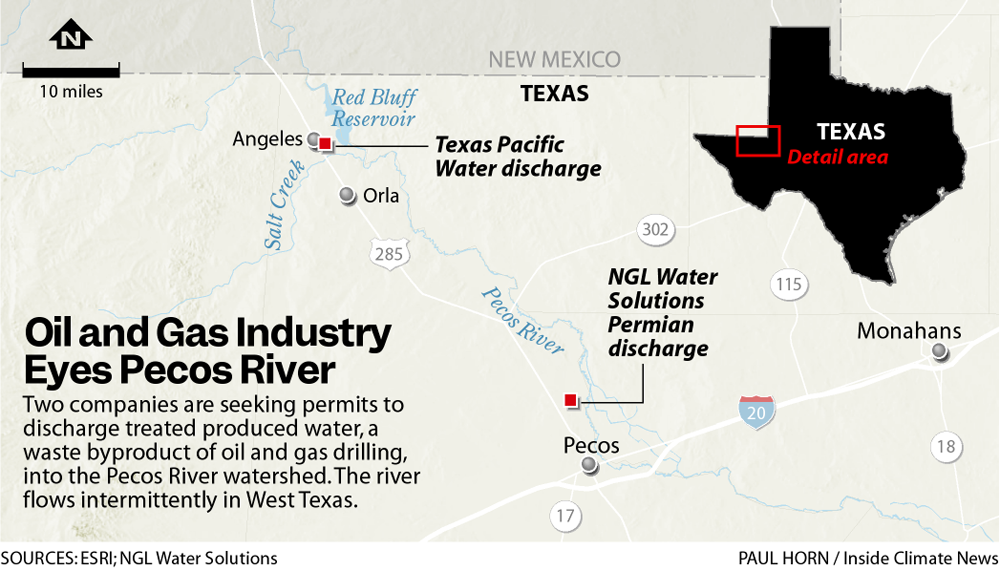
TCEQ’s Richter said the agency received four permit applications to discharge produced water during 2023 and 2024. Texas Pacific Water Resources and NGL Water Solutions Permian both applied for permits in the Pecos River watershed of the Permian Basin.
Another two applications are in the Eagle Ford Shale. In Atascosa County, TCEQ granted Dorchester Operating Company a permit to discharge treated oil and gas wastewater into three unnamed tributaries that feed into the Lower Atascosa River. TCEQ is currently reviewing a permit application from CMR Energy to discharge up to 653,000 gallons per day of treated oil and gas wastewater east of Eagle Pass into Comanche Creek and its tributaries, which flow into the Nueces River. The discharge is expected to contain chloride, petroleum hydrocarbons and naturally occurring radioactive materials, according to TCEQ records.
For discharges east of the 98th Meridian, TCEQ first had to obtain authorization from the EPA to create a permit program, as previously reported in Inside Climate News. TCEQ issued the first of these permits to Baywater Operating in Harris County, according to Richter. Baywater’s permit was terminated in March 2024 because the company was no longer discharging.
Texas has site-specific water quality standards for segments of different waterways, including the Pecos, Richter said. This means TCEQ permits different levels of pollutants depending on the conditions of that specific river.
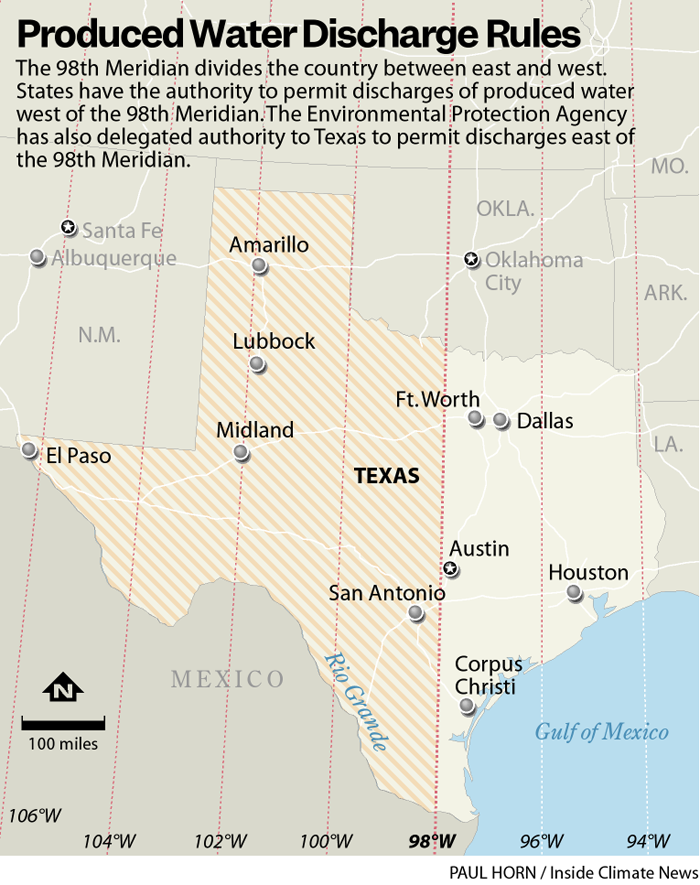
Amy Hardberger, a professor of water law and policy at Texas Tech University, said more research and review is needed to determine appropriate uses of produced water. “The Clean Water Act never contemplated this water going into rivers and streams,” she said.
In a forthcoming paper, Hardberger points out that many of the constituents in produced water are difficult or costly to test for and do not have established EPA toxicity standards. These are numerical values measuring the risk presented by exposure to a chemical or contaminant. She compares the EPA’s list of standards for public water supplies, which includes exposure guidelines for approximately 90 contaminants, with the over 1,100 chemicals that have been found in produced water.
And she warned that the science on public safety shouldn’t be rushed to find a quick fix for produced water disposal.
“What’s driving the train on this is not water shortage and the potential of an additional water supply,” she said. “What is really driving the change is they are running out of disposal opportunities.”
The EPA did not respond to questions for this story.
Two Permits Pending in the Pecos Watershed
The Pecos River runs from the mountains of Northern New Mexico into the arid scrubland of West Texas and eventually joins the Rio Grande. The river passes through areas of intensive oil and gas drilling and has also been plagued by salinity problems.
Texas Pacific Water Resources’ permit application states that discharges will be beneficial for aquatic species downstream of the discharges into Salt Creek. The creek is home to the Pecos pupfish, a threatened species in Texas that only lives in a few locations in the watershed.
Crain said Texas Pacific Water Resources has developed a process to treat the wastewater up to discharge standards cost-effectively. The technology remains undisclosed while patents are pending, he said, but is already used in the nuclear and commercial food products sectors.
He said the company collaborated with research groups in several states to identify contaminants in produced water and develop means to test for their presence. The company ran a greenhouse study growing various grasses with its treated water and has sent them to a lab to check for accumulation of toxins.
Crain said the company has “gone beyond what’s currently regulated” to test samples for compounds that have been identified in produced water. Those results were included in the company’s application to TCEQ. The testing found constituents including Radium-226 and Radium-228, types of naturally occurring radioactive material, and benzene, ethylbenzene, toluene and xylene, which are elements found in crude oil and gas production. There were also detectable amounts of some PFAS chemicals in the samples.
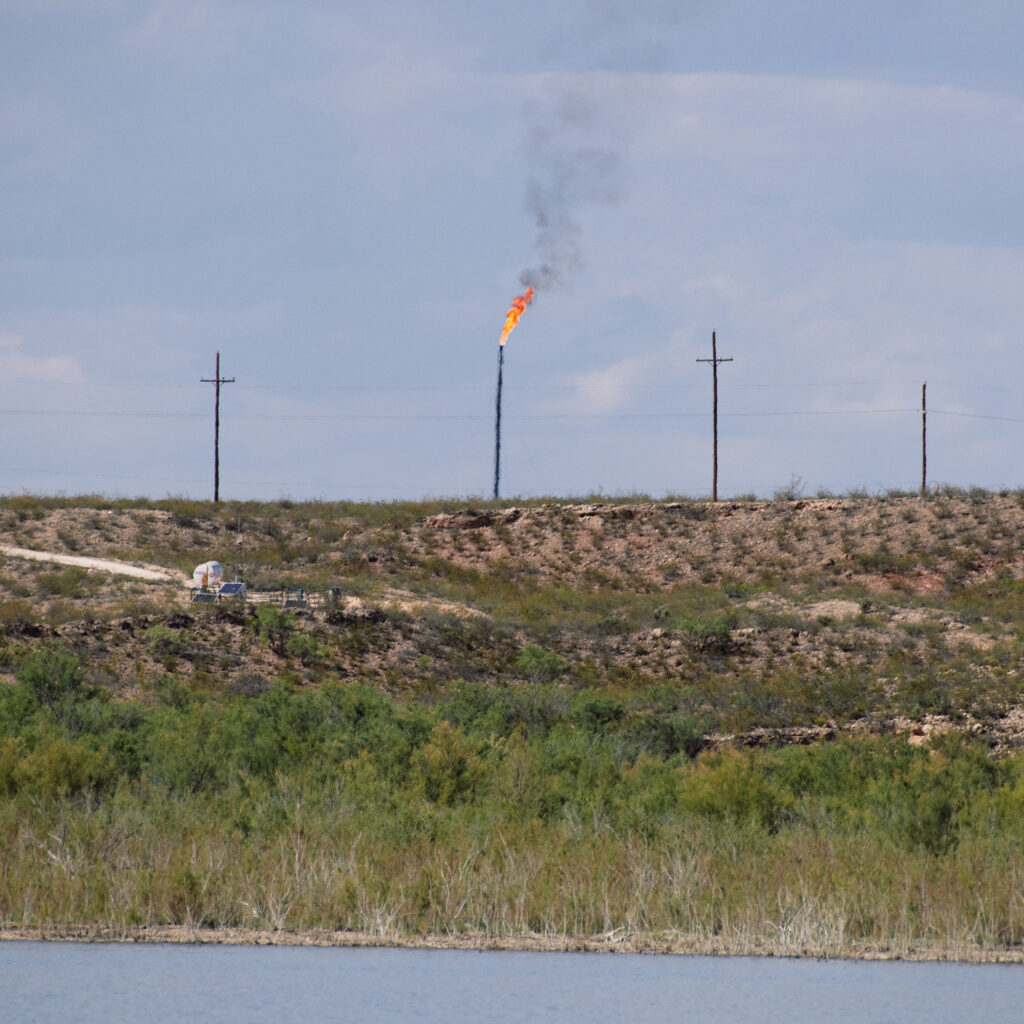
Adrianne Lopez, the company’s research and development manager, said that the company will reduce constituents including Radium-226 and Radium-228 to the TCEQ-recommended level. They are also working with researchers at New Mexico State University to conduct human health risk assessments and whole effluent toxicity testing to determine safe levels.
Now it is TCEQ’s turn, based on this data, to set standards for the quality of the water to be discharged.
NGL Water Solutions Permian applied to discharge up to 16.9 million gallons per day of treated produced water near the Red Bluff Reservoir on the Pecos River in Reeves County. The company is a subsidiary of Tulsa-based NGL Energy Partners.
Discharged water will include trace amounts of organics, ammonia, volatile organic compounds and total dissolved solids, according to a TCEQ public notice. An NGL representative declined to comment for this story, saying that permitting details were still being determined with TCEQ. The agency administratively approved the permit and is now completing technical review.
NGL has an existing discharge program in Wyoming’s Anticline Basin. According to the company website, NGL discharges nearly 11,000 barrels per day or four million barrels per year in Wyoming.
Produced water discharges in Wyoming have recently come under scrutiny. The state environmental regulator reported that several sections of streams where produced water is discharged are polluted to the point they no longer support aquatic life. Last year regulators issued a violation to Dallas-based Aethon Energy Operating for exceeding permitted levels of sulfide, barium and radium in its discharges, according to the news outlet WyoFile.
Texas Backs Produced Water Reuse
Officials in Texas have identified produced water reuse as a core strategy to address forecasted regional water shortages. A billion-dollar water fund passed last year provides money for projects that bring new water supplies to the state.
According to state Sen. Charles Perry, eligible strategies include seawater desalination, groundwater desalination, inter-state agreements and produced water reuse.
Money from the new water fund should “be used solely to finance the development and acquisition of new water supply,” Perry wrote in a letter to the Texas Water Development Board. “This means water supply that is truly a new input into the state water cycle.”
This story is funded by readers like you.
Our nonprofit newsroom provides award-winning climate coverage free of charge and advertising. We rely on donations from readers like you to keep going. Please donate now to support our work.
Texas lawmakers also passed a bill in 2021 creating the Texas Produced Water Consortium, which brings together academic, industry and non-profit representatives to research the issue. A 2023 bill provided additional funding for the consortium to start pilot projects for produced water reuse.
The consortium, based at Texas Tech University, is preparing a report for the state legislature in the fall with updates on research into produced water and pilot projects. A representative of the consortium said its Standards Committee is compiling a database of water quality guidelines from multiple states, which includes hundreds of constituents that could be in produced water.
While there is still a long way to go, Ira Yates, of Friends of the Pecos, said he’s “very optimistic” that discharges could be beneficial for the Pecos River in the future.
“But I’m also very concerned,” he said, “that the people talking about putting the water back in the Pecos do not understand the hydrology and the river issues.”




